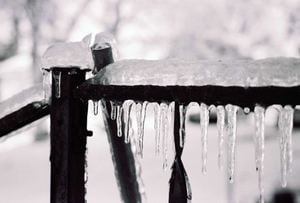Salt is, without a doubt, the least expensive product available for melting snow and ice. Salt is effective and works fast, but, it is not the safest choice. Salt can cause property damage, injure pets, kill plant life, and more. This winter, try a different approach to melting snow and ice with these smart salt alternatives.
What’s so bad about using salt?
If you live in an area of the country that receives snow, chances are you’ve had experience in shoveling snow. Not a fun job, is it? If you’ve never done it, let me tell you this – It is backbreaking labor! It’s heavy, it’s cold, and it can become a never ending job if you don’t keep up with it. Because of this, salt sells like crazy! People sprinkle it on their porch, patio, driveway, and sidewalk areas to melt snow and ice. It works great, but it can cause major damage to concrete. Have you ever noticed those small pits and pockmarks on the driveway? They are a result of using salt to melt ice and snow. But this is just the tip of the iceberg – Ice can also cause damage to the following:
Pets – Pets go outside and come back in with salt on their paws. In turn, they lick their paws to remove the salt. This can cause stomach irritation, diarrhea, lethargy, and vomiting. Salt that settles in the pads of their paws can also cause skin irritation.
Metal – When salt comes in contact with metal, it can corrode and destroy it. This means it can damage patio furniture, metal fencing and gates, metal yard ornaments and statues, and even your car!
Plant life – Landscaping in the spring can be expensive and time consuming. You certainly don’t want to kill off the plants you planted in the spring and summer with the salt you use to melt snow and ice in the winter. Salt stops airflow, dehydrate plant cells, and kills plant life.
Concrete – As mentioned above, salt damages concrete. But, this damage is not limited to driveways. If the salt comes in contact with the concrete foundation of your home, it can ‘pit’ the surface of it too. Overtime, those pits become larger and deeper, and can potentially turn into large cracks.
Affordable salt alternatives
Since we cannot go without using something to clear the walkways and driveways in the winter, we must look for salt alternatives for melting snow and ice. Here are some affordable options:
Salt-free deicer – Many homeowners purchase salt-free deicers because they are safe to use around pets. Products such as SafePaw are 100% safe to use and works just as well as salt. Other brands are available that are eco-friendly salt alternative which won’t harm plant life or property.
Natural Cat Litter – It may not melt snow and ice, but natural cat litter will help provide traction for walking and driving when sprinkled on driveways and walkways. This product is also an eco-friendly alternative to salt because it contains no added chemicals and is 100% safe to use around children, pets, and plant life.
Straw, wood chips, gravel, deer corn, sand, cedar, and saw dust, are all materials that can be used to provide traction on snow or ice covered surfaces. They won’t actually melt the snow, but they will help to prevent falls and injury.
Pricey salt alternatives
If you have the money to spend, there are more permanent solutions to keeping walkways and driveways free of icy dangers. These salt alternatives include:
Heated driveways – If you have a permanent residence and several thousand dollars to spend, you can have a heated driveway installed. Shoveling snow will never be on your ‘to do’ list again. Material can be added to virtually any driveway surface, which melts snow and ice with no effort from you.
Heated stair mats – A more affordable alternative are heated stair mats. The mats cost around $ 100 for a set of two, and they simply set on top of your outdoor stairs. When they are covered with snow, you stomp them with your feet to loosen the snow and sweep it away. No shoveling required.
Heated traction mats – These mats are a larger version of the stair mats, covering entire pathways to prevent slips and falls. For a price of several hundred, to thousands of dollars, you can enjoy safe passage to the mailbox, driveway, or wherever the mats are placed.
More from Jennifer Wagner:
Space Heater Safety Tips
Home Winterization Tasks
Is Your Home Ready for Cold Weather?
Source: Personal knowledge
